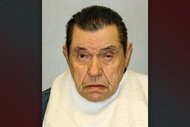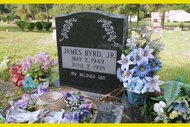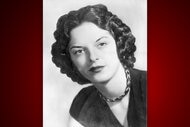Create a free profile to get unlimited access to exclusive videos, breaking news, sweepstakes, and more!
Rediscovering The Legacy Of America's First Prominent Black Detective And The Case That Made Him Famous
John Baptiste Jourdain once dominated newspaper headlines, but his legacy has been forgotten. His family wants the world to know his story

In honor of Black History Month, Oxygen.com is highlighting the stories of Black pioneers in criminal justice.
It was 1870 and newspaper headlines across America were fixated on a kidnapping case in New Orleans. Mollie Digby, a blond and blue-eyed white baby girl, was allegedly kidnapped by two Afro-Creole sisters. Rumors swirled that the 17-month-old daughter of Irish immigrants was abducted for a voodoo sacrifice.
The case also had something that the U.S. had never seen during Reconstruction or any other prior era: a Black detective – 40-year-old John Baptiste Jourdain. Even the role of detective was relatively new to America’s police forces. Up until the 1840s police departments focused on preventing crimes not solving them, according to Michael A. Ross, author of The Great New Orleans Kidnapping Case: Race, Law, and Justice in the Reconstruction Era.
“Now Jourdain, a Black detective, was assigned to a major case in the South’s largest metropolis, following leads, interrogating white and Black witnesses, and using his detective skills to solve a sensational crime. The Digby investigation was the first case to make national news that featured a Black sleuth,” Ross, a history professor at the University of Maryland, writes in the book.
Jourdain’s pioneering role was due to Reconstruction and 28-year-old Governor Henry Clay Warmorth eager to restore law and order to a city known for its violence and crimes and to assuage the doubts of whites angered by the idea of Black men patrolling New Orleans with the rights to arrest anyone regardless of their skin color.
“He’s not just keeping the peace, but he’s making a statement about Black dignity… Black rights, Black freedom. This is a civil rights struggle,” Lawrence N. Powell, professor emeritus of History at Tulane University told Oxygen.com. “Frederick Douglas said without struggle, there is no progress, right? He’s one of the vanguards in that struggle.”
Jourdain, an Afro-Creole, was well versed in the groundbreaking investigative techniques that originated in France. He also used deductive reasoning and wore disguises, especially during his work on the Digby case.
John Bardes, a history professor at Louisiana State University said that Jourdain joined a force that was being upgraded from “a low-paying job that attracted very poor men … [where] there wasn’t much in the way of standards or qualifications for the job.”
Newspaper articles described Jourdain as “intelligent and well educated” and “slightly colored.”
At the time, 28% of the New Orleans police force was African American; among their ranks were Jourdain, a former Union officer during the Civil War, and his brother, Victor. The city was breaking new ground. Boston would not integrate its force until 1878 and New York’s police remained all-white until 1911, according to Ross.
“Throughout his life, he had felt the ill effects of living under a poorly trained and racist department. The savagery of the New Orleans Riot confirmed what he already knew: an all-white police force would never fully protect Black people’s lives, liberty, or property,” Ross writes.
But Jourdain was keenly aware that the job would not be an easy one. Every day he was confronted by white resentment. Black officers were frequently insulted, threatened and attacked, according to Ross. At one point, the police chief was so worried about the safety of his Black officers that he ordered them to remove their uniforms and hide until a white mob disbanded.
Ross told Oxygen.com one of the reasons Jourdain was selected for the force was the need for men who would remain restrained and wouldn’t take the bait of racists.
And Jourdain proved up to the task, heading several investigations that received media attention, but the Digby case was by far the most important and high-profiled of his career.
The search dragged on from June until August with newspaper articles questioning the proficiency of the police force and a national audience desperate for any new developments. Eventually, two sisters: Ellen Follin and Louisa Murray were arrested. Both insisted that a white woman wearing a veil over her face turned up at Follin’s home asking her to keep the child until she returned from the grocery store. The sisters had a different timeline for when the baby arrived, but both swore that the woman never returned.
Another lurid facet of the case – both women ran so-called “lying hospitals” – where white women with reasons to hide their pregnancies went to deliver their babies without the prying eyes and whispers of family, friends, and neighbors.
Follin feared she would be accused of kidnapping the child and reached out to James Madison Broadwell — a renowned steamboat captain — and his wife, to return the girl.
At first, Thomas Digby did not recognize his daughter, who had two boils on her face. At the time of her kidnapping, she was described as having a boil on the back of her head. But Bridgette Digby, who had a nervous breakdown and was hospitalized during Mollie’s absence, recognized the girl immediately. She later claimed that the now 19-month-old Mollie cried “Mammy! Mammy,” after seeing her, according to Ross.
The trial started in January of 1871 and after eight minutes of deliberations, an integrated jury found both women not guilty. Jourdain shouldered much of the blame for the women going free and eventually was demoted and left the force, Ross said.
Bardes said that New Orleans had a multi-racial police force in the 1820s, but as racial tensions intensified, all those Black men were purged from the force, and it happened again, when Reconstruction collapsed in the 1870s.
Unfortunately, Jourdain vanished from history. The case made headlines when the baby of aviation legend Charles Lindbergh was kidnapped in 1932, more than 60 years later. But newspapers claimed the sisters were convicted and Jourdain was never mentioned. An unpublished Digby family memoir written in the 1930s claims that white detectives who sometimes wore blackface investigated the case, according to the New York Times.
“By [the]1930s, Reconstruction was so forgotten no one could even believe there had been Black police,” Ross told the New York Times.
“His is a forgotten legacy. … He was probably one of the great standup guys of the community,” Powell said. “These foot soldiers of freedom and equality — these are the ones that really need to be remembered.”
Eighteen years after the Digby case, with Louisiana now part of the Jim Crow South, Jourdain took his own life. Some speculate that he was despondent after battling malaria; others suggest that he was broken hearted over the failure of Reconstruction.
“Today we look at Reconstruction – like it’s a done deal that Jim Crow is on the way. And that’s not how it looked on the ground in 1870. It looked like this could work. And folks like Jourdain had this moment where they thought that the world was going to change. And at the time that he kills himself, it is clear that it is not,” Ross said.
“Things are going backwards. The possibilities for people like him are dwindling. He isn’t feeling well. … He’s forced to take a menial job working for a friend in a furniture place, and he’s just had enough and he’s just tired of life, and he went out into the St. Louis Cemetery and sat down on the steps of his father’s grave and killed himself. It’s kind of a dark ending to the tale, but poignant.”
Now, the Baquet family – descendants of the Jourdain brothers – are known primarily for cooking and journalism. Wayne Baquet, owned and operated several restaurants, before retiring including the famed Lil Dizzy’s in New Orleans. His brother, Dean Baquet is the executive editor of the New York Times and another brother Terry, is Page one Editor of the Times-Picayune.
His descendants said they were unaware of his historic role until about 20 years ago. Ross’s book was published in 2014.
“I didn’t even know that he was part of the family,” Wayne Baquet, Jourdain’s nephew told Oxygen.com.
“It was a huge surprise. I had no idea,” Isabel Baquet, who married Wayne’s nephew, told Oxygen.com. “Much of our history (African Americans) is not passed down from generation to generation, and part of the history has been lost. It is there, but you need somebody that’s patient and savvy to dig and find out information like that. We found documentation.”
Now she wants the world to know his story, but she has another dream as well.
Baquet wants to visit the African American Civil War Memorial in Washington, D.C. and trace the names of John Baptiste Jourdain and his brother, Victor. Their names along with the more than 200,000 Black men who fought for the Union during the Civil War are etched into stainless still panels.


























